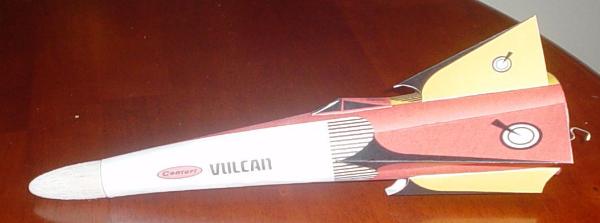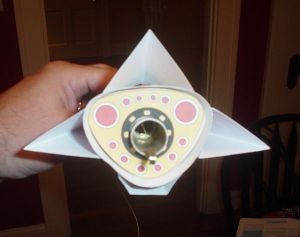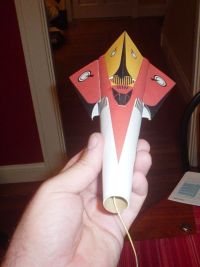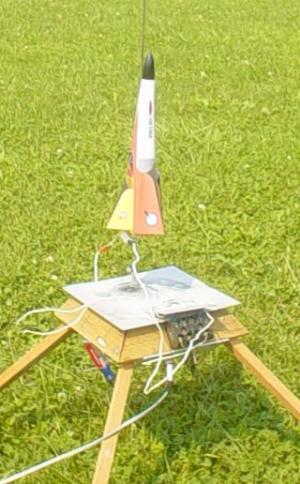| Construction Rating: | starstarstarstarstar |
| Flight Rating: | starstarstar_borderstar_borderstar_border |
| Overall Rating: | starstarstarstar_borderstar_border |
| Manufacturer: | Clone |
Brief:
As a part of the Centuri "paper brigade" that included the Point and the X-24 Bug, the Vulcan always looked like an intriguing rocket to clone. Despite having printed out the patterns I couldn't bring myself to start the project. Something about the idea of constructing a rocket out of pre-printed paper intimidated me to no end, so the sheets sat untouched in my files for several years before I realized that if I screwed up, I could print more and try again! Amazing how long it sometimes takes the simplest things to filter through, isn't it? (Or maybe it's just me...)

Construction:
The instructions can be found here: http://www.dars.org/jimz/ka-10.htm and the parts needed are:
- Two sheets of heavy bond paper
- Semroc ST-8 body tube
- Semroc balsa nose cone
- 18mm engine hook
- 18mm engine block
- 24mm centering ring for engine hook hold down
- 3/32" basswood bulkhead
- 30" Kevlar shock cord
- 24" length of 1/8" sewing elastic
To start, let me say how pleasantly surprised I was with the speed with which this project went once I got started. Although I had cut out all of the pieces several years earlier, I hadn't folded or curled any of them--the big reason being that I figured this would be the most difficult part of the project. Not even close. I began by curling the large body section of the rocket by pulling it out from under a metal ruler several times at an angle. This eventually gave something of a permanent curve to the paper, which I made more pronounced by rolling it inside another piece of paper. When the paper stayed curved almost into the needed shape, I lined up the tabs and began taping the shroud on the inside, always taking care to keep things as lined up as possible. Old-fashioned cellophane tape or thin masking tape is useful in this part of the project because it allows you to reposition things more easily than "Magic" tape. Once I had the shroud edges lined up satisfactorily, I laid down a line of gel-type CA, then repeatedly worked my thumb over the seam until the CA grabbed with something resembling permanence. Believe it or not, this was the most difficult part of the project. Once this was done I began attaching the folded fins using the gel CA. As shown in the pictures, I only attached the fins one tab at a time, which not only gave the glue time to set up before the fin had to be touched to attach the next tab but also allowed me to securely fasten the launch lugs which provide strength to the fins as well as the actual launch lug.
 Once the rocket's basic shape was defined with the application of the fins, scoops and cockpit, I started on the internals. I began this part of the project by cutting the rear bulkhead out of a scrap piece of 3/32" basswood. When the ragged edges were cleaned up and it was sanded to shape, I glued the printed bulkhead cover over the assembly then began the process of cutting out the hole for the motor tube and engine hook. This was another step where a rough cut was made via the knife then cleaned up with sandpaper later on. The internals consisted of a length of Semroc ST-8 tubing, an 18mm Estes engine hook, a CR-520 centering ring that acts as an engine block, and a CR-2050 that acts as a engine hook hold-down. This is assembled in the traditional manner with the added touch of a 30" length of Kevlar shock cord glued in with the engine block. Once this was together, I slid the bulkhead into place around the rear of the engine tube, coated the forward end of the tube with the gel CA, and worked the whole assembly into it's approximate place in the paper shroud, while carefully keeping the engine hook oriented in the correct position relative to the bulkhead. When I was sure that the glue at the front end had set securely, I glued the rear bulkhead into position with regular white glue and build fillets around both the place where bulkhead and shroud met as well as the place where the bulkhead and the engine tube met. With the body of the rocket complete, I turned my attention to the nose cone.
Once the rocket's basic shape was defined with the application of the fins, scoops and cockpit, I started on the internals. I began this part of the project by cutting the rear bulkhead out of a scrap piece of 3/32" basswood. When the ragged edges were cleaned up and it was sanded to shape, I glued the printed bulkhead cover over the assembly then began the process of cutting out the hole for the motor tube and engine hook. This was another step where a rough cut was made via the knife then cleaned up with sandpaper later on. The internals consisted of a length of Semroc ST-8 tubing, an 18mm Estes engine hook, a CR-520 centering ring that acts as an engine block, and a CR-2050 that acts as a engine hook hold-down. This is assembled in the traditional manner with the added touch of a 30" length of Kevlar shock cord glued in with the engine block. Once this was together, I slid the bulkhead into place around the rear of the engine tube, coated the forward end of the tube with the gel CA, and worked the whole assembly into it's approximate place in the paper shroud, while carefully keeping the engine hook oriented in the correct position relative to the bulkhead. When I was sure that the glue at the front end had set securely, I glued the rear bulkhead into position with regular white glue and build fillets around both the place where bulkhead and shroud met as well as the place where the bulkhead and the engine tube met. With the body of the rocket complete, I turned my attention to the nose cone.
 Since I had built the Vulcan using Semroc tubing, it stood to reason that I'd need a Semroc nose cone to fit the tube. Luckily Carl had thrown one in when I ordered a couple of each of their body tubes a few months earlier, and even luckier for me, it was pretty much an exact match for the cone I needed. Since I needed a fairly hefty amount of nose weight, I searched the tool box for several short, heavy screws. I found two that fit the perfectly and added an equally hefty screw eye for even more weight. With little to compare it to, this would have to do. Finally, after sealing the nose cone, painting it gloss black, and adding a Semroc parachute along with two additional feet of sewing elastic shock cord, I felt that the Vulcan was ready to fly.
Since I had built the Vulcan using Semroc tubing, it stood to reason that I'd need a Semroc nose cone to fit the tube. Luckily Carl had thrown one in when I ordered a couple of each of their body tubes a few months earlier, and even luckier for me, it was pretty much an exact match for the cone I needed. Since I needed a fairly hefty amount of nose weight, I searched the tool box for several short, heavy screws. I found two that fit the perfectly and added an equally hefty screw eye for even more weight. With little to compare it to, this would have to do. Finally, after sealing the nose cone, painting it gloss black, and adding a Semroc parachute along with two additional feet of sewing elastic shock cord, I felt that the Vulcan was ready to fly.
Finishing:
Since everything was already printed on the shroud, finishing it was a snap. After printing, I sprayed the paper with a coat of Krylon Acrylic Clear. The only actual painting that needed to be done was of the nose cone, as I described in the previous step. That's my kind of project!
Construction Rating: 5 out of 5
Flight:
The day I chose to first fly the Vulcan was a hot, sticky Sunday before Labor Day when everyone else in town was hanging around on the riverfront awaiting the fireworks. Anticipating some fireworks of my own, I lugged several newly cloned rockets and some old favorites to a local baseball complex where I had played Little League a few years earlier. (Okay, more like 35 years earlier, but who's counting?) One of my fellow Quarkers and I had  recently adopted it as an off-week-at-VOA flying field because of it's fairly expansive landing area and it's relatively centralized location to our respective homes. We located our prep areas in the shade of two small trees near the playground, which did wonders for our ability to log over twenty flights between us despite the heat. The Vulcan was the second of my rockets on the pad that day, and I conservatively chose a 1/2A6-2 for the flight. (Okay, maybe I was a little TOO conservative.) The Vulcan cleared the rod, but just barely. The flight topped out well short of 100 feet, but the 2 second ejection charge easily deployed the parachute before things could get tense. The flight had been short from the altitude standpoint, but the fact that it was stable was what I was most interested in. I decided that baby steps were the way to go and for the second flight decided on an A8-3. Unfortunately, flight #2 was a whole different experience compared to flight #1. The Vulcan began wobbling badly as soon as it left the rod, and the wobble rapidly became more pronounced as the engine continued to burn. Things didn't get any better during the coast phase as burnout had left the rocket in a nose down position and the hard dirt of the ball field was coming up fast. Impact and ejection arrived far too close together, but the Vulcan survived with only a bent fin in the way of damage.
recently adopted it as an off-week-at-VOA flying field because of it's fairly expansive landing area and it's relatively centralized location to our respective homes. We located our prep areas in the shade of two small trees near the playground, which did wonders for our ability to log over twenty flights between us despite the heat. The Vulcan was the second of my rockets on the pad that day, and I conservatively chose a 1/2A6-2 for the flight. (Okay, maybe I was a little TOO conservative.) The Vulcan cleared the rod, but just barely. The flight topped out well short of 100 feet, but the 2 second ejection charge easily deployed the parachute before things could get tense. The flight had been short from the altitude standpoint, but the fact that it was stable was what I was most interested in. I decided that baby steps were the way to go and for the second flight decided on an A8-3. Unfortunately, flight #2 was a whole different experience compared to flight #1. The Vulcan began wobbling badly as soon as it left the rod, and the wobble rapidly became more pronounced as the engine continued to burn. Things didn't get any better during the coast phase as burnout had left the rocket in a nose down position and the hard dirt of the ball field was coming up fast. Impact and ejection arrived far too close together, but the Vulcan survived with only a bent fin in the way of damage.
A week later I tried again, only with bigger engines. The B6-4 flight wobbled somewhat but boosted to a respectable height and recovered without damage. The C6-5 flight wobbled a lot--to the point that the smoke trail had a distinct coil shape to it but never reached the point where it looked out of control. (Well, not COMPLETELY!) I'll try to wedge some more nose weight into the cone, but based on what some of the other fliers said that day, these flights were pretty much the norm for this bird. I'll keep trying.
Flight Rating: 2 out of 5
Summary:
PROs:
- EASY build. It's possible to build and fly the Vulcan overnight.
- Big attention getter at the pads.
- NO PAINTING! NO SEALING!! NO SANDING!!!
CONs:
- Erratic flights (?)
- Difficult to determine the thickness of the paper stock to be used.
Overall Rating: 3 out of 5
#Related Reviews
- Scratch Big Blue Vulc By John Lee
BT70 Upscale of Centuri Vulcan with 7x18mm Motor Mount Construction began with the building of the 7x18mm motor mount from Fliskits meant for the BT70 tube. This was interesting in that normally, 7x18mm mounts will not fit in this tube without some deformation. Fliskits came up with an ...
- Scratch Vulcan 60 By John Lee
Brief: Since I was a kid, I have always been captivated by the paper shrouded rockets like "The Point". My biggest nemesis, however, was always the Centuri Vulcan. I built lots of them but never got one to behave or even look very good...until I became a BAR and cloned one. It's not the best flier ...
Related Products
 |
 |